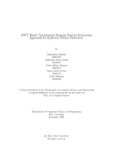| dc.contributor.advisor | Parvez, Mohammad Zavid | |
| dc.contributor.advisor | Abrar, Mohammed Abid | |
| dc.contributor.author | Mostafa, Mahajabin | |
| dc.contributor.author | Samin, Mohtasim Abrar | |
| dc.contributor.author | Hassan, Nabila Bintey | |
| dc.contributor.author | Nibras, Saiara Zerin | |
| dc.contributor.author | Rahman, Samir | |
| dc.date.accessioned | 2021-12-02T05:04:33Z | |
| dc.date.available | 2021-12-02T05:04:33Z | |
| dc.date.copyright | 2021 | |
| dc.date.issued | 2021-09 | |
| dc.identifier.other | ID 18101458 | |
| dc.identifier.other | ID 18101094 | |
| dc.identifier.other | ID 18101237 | |
| dc.identifier.other | ID 18101251 | |
| dc.identifier.other | ID 18101130 | |
| dc.identifier.uri | http://hdl.handle.net/10361/15687 | |
| dc.description | This thesis is submitted in partial fulfillment of the requirements for the degree of Bachelor of Science in Computer Science and Engineering, 2021. | en_US |
| dc.description | Cataloged from PDF version of thesis. | |
| dc.description | Includes bibliographical references (pages 30-35). | |
| dc.description.abstract | Epileptic seizure is a neurological disorder that is prevalent in both males and females
of all age ranges. Detection of epileptic seizure serves as an important role
for epileptic patients as it allows the initiation of systems to prevent injuries and
limiting the possibilities of risk by providing targeted therapy by anticipating their
onset prior to presentation. Electroencephalogram (EEG) plays an important role
in seizure detection and is one of the most well-known techniques for determining
stages of epilepsy. Since, EEG is a non-stationary signal it can be quite difficult
to di↵erentiate amongst seizure activity and normal neural activity. In this paper
we have proposed an epilepsy detection method based on five di↵erent feature
extraction methods and followed by that the original domain of the extracted features
were transformed using DiscreteWavelet Transform (DWT) and three di↵erent
classifiers- Decision Tree, Random Forest and KNN to classify into seizure and nonseizure
stages. Results demonstrated in this paper have outperformed the existing
state-of-the-art methods with 97.22%, 100% and 83.33% for 2 class classification
and 91.67%, 91.67% and 80.56% for 4 class classification for the aforementioned
classification techniques accordingly. | en_US |
| dc.description.statementofresponsibility | Mahajabin Mostafa | |
| dc.description.statementofresponsibility | Mohtasim Abrar Samin | |
| dc.description.statementofresponsibility | Nabila Bintey Hassan | |
| dc.description.statementofresponsibility | Saiara Zerin Nibras | |
| dc.description.statementofresponsibility | Samir Rahman | |
| dc.format.extent | 35 pages | |
| dc.language.iso | en | en_US |
| dc.publisher | Brac University | en_US |
| dc.rights | Brac University theses are protected by copyright. They may be viewed from this source for any purpose, but reproduction or distribution in any format is prohibited without written permission. | |
| dc.subject | DWT | en_US |
| dc.subject | Transformed domain | en_US |
| dc.subject | EEG | en_US |
| dc.subject | Feature extraction | en_US |
| dc.subject | Classification | en_US |
| dc.subject.lcsh | Electroencephalography. | |
| dc.subject.lcsh | Wavelets (Mathematics) | |
| dc.subject.lcsh | Signal processing--Digital techniques--Mathematics | |
| dc.title | DWT based transformed domain feature extraction approach for epileptic seizure detection | en_US |
| dc.type | Thesis | en_US |
| dc.contributor.department | Department of Computer Science and Engineering, Brac University | |
| dc.description.degree | B. Computer Science | |

